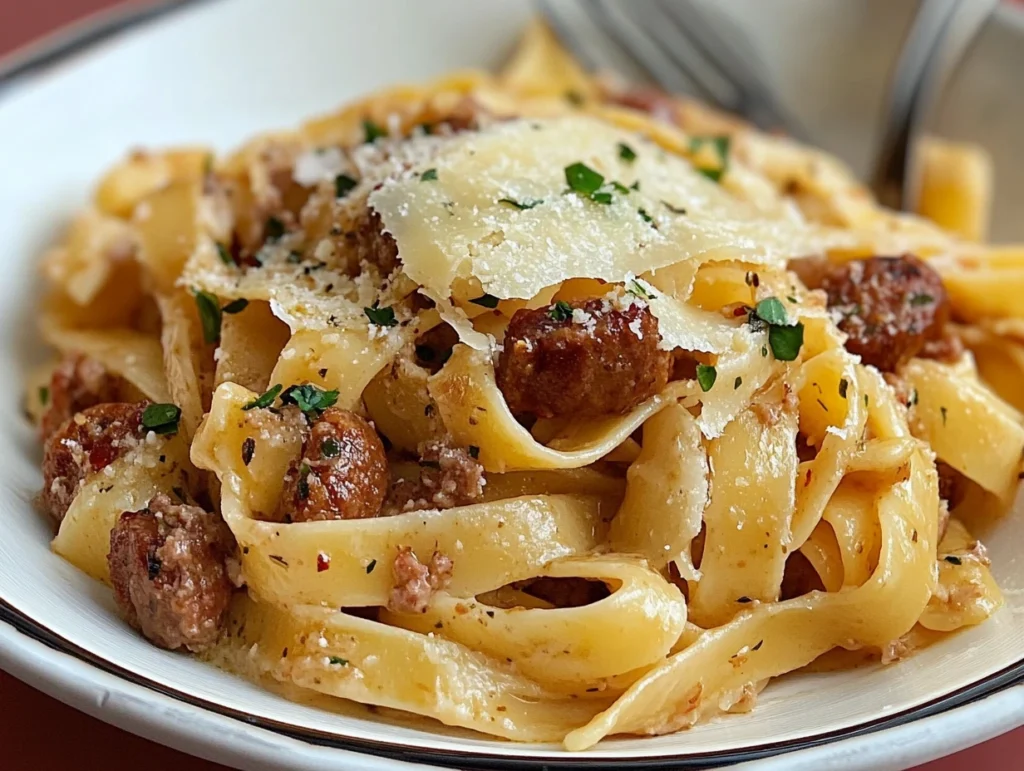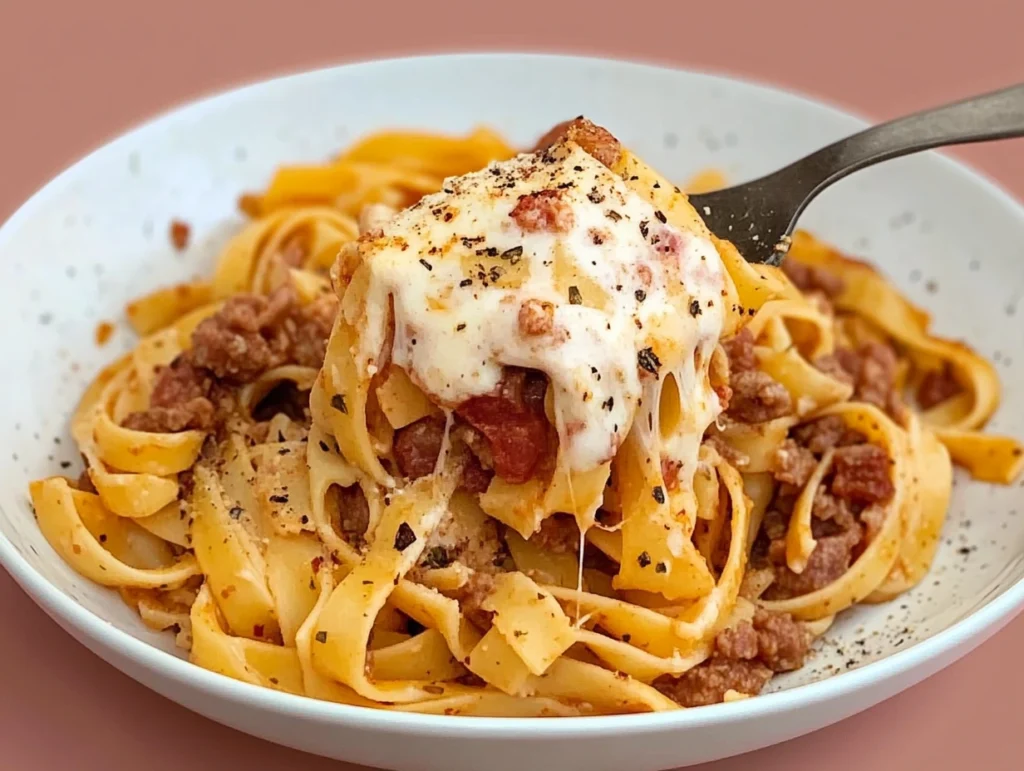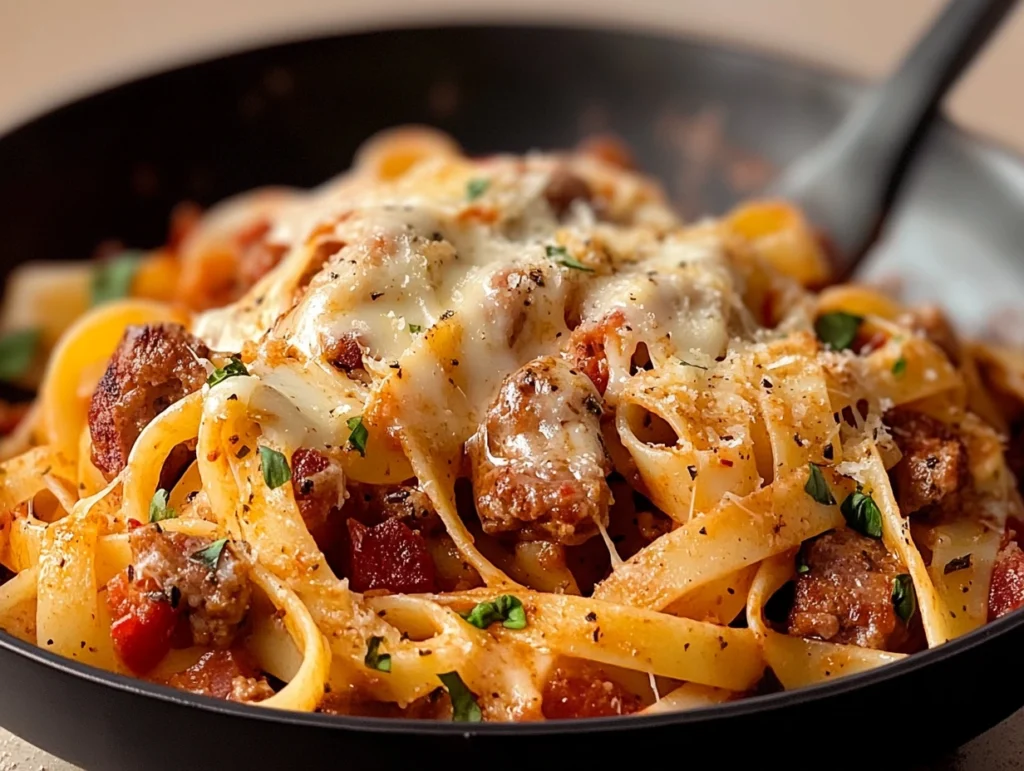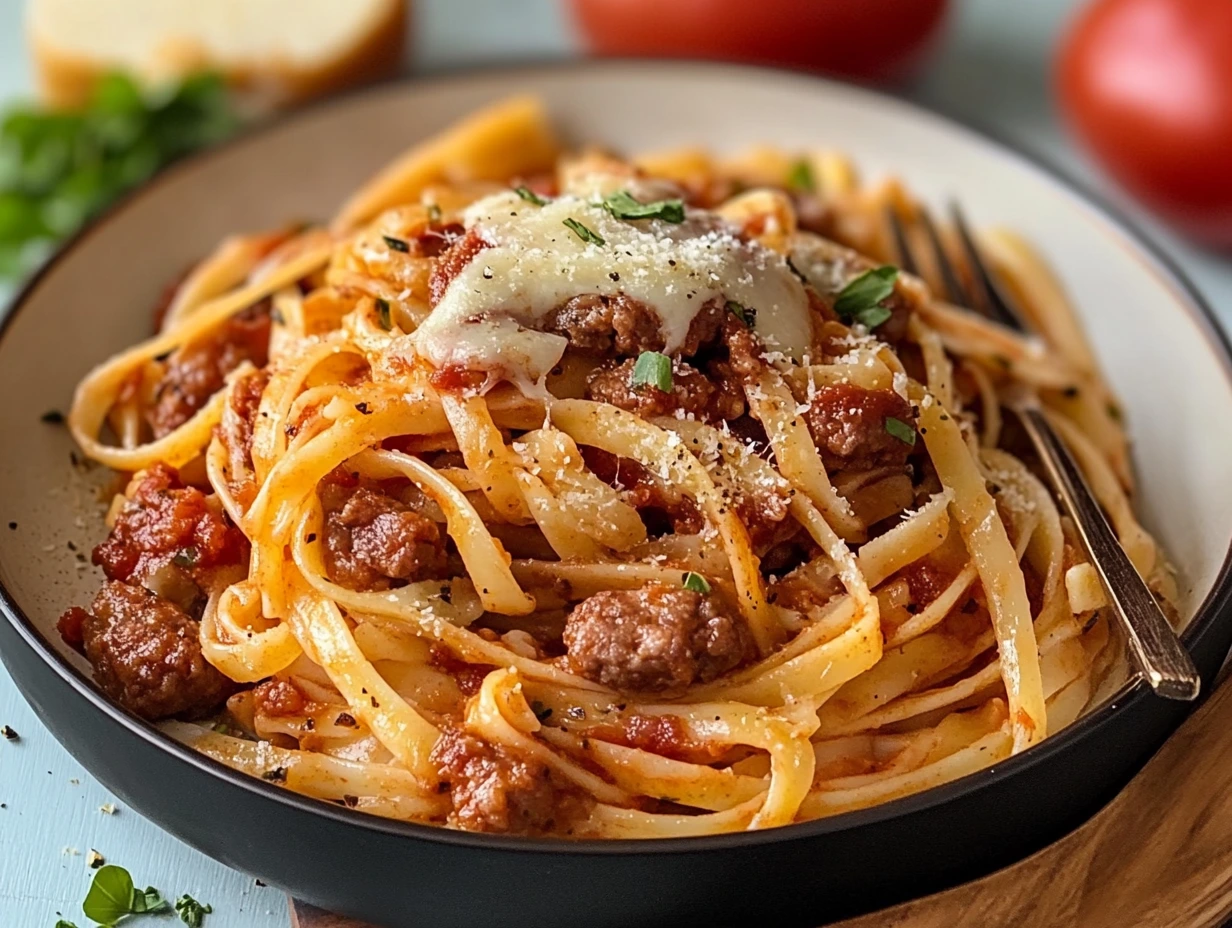Sausage pasta is a timeless dish that merges the hearty flavors of seasoned sausage with the comforting embrace of pasta. This culinary pairing has its roots in Italian cuisine, where robust sausage recipes have been passed down for generations. Over time, this simple yet versatile dish has evolved, incorporating regional twists and becoming a global favorite.
Table of Contents
The Flavor Profile of Sausage Pasta
Sausage pasta tantalizes the taste buds with its perfect balance of flavors. The savory and spiced notes of sausage blend beautifully with the richness of tomato-based or creamy sauces. Aromatic herbs like basil, oregano, and parsley add freshness, while garlic and onions provide depth. Combined with the hearty texture of pasta, every bite is a comforting explosion of flavors.
Essential Ingredients for Sausage Pasta
Core Ingredients
- Sausage: Choose Italian sausage (sweet or spicy) for the best flavor. Pork, chicken, or turkey sausage works well depending on your preference.
- Pasta: Penne, rigatoni, or spaghetti are great options, but any pasta shape can be used.
- Sauce: A rich marinara, a creamy Alfredo, or a zesty vodka sauce are excellent choices.
- Vegetables: Common additions include bell peppers, spinach, mushrooms, or zucchini for added nutrients and texture.
- Seasonings: Garlic, onion, crushed red pepper flakes, and Italian seasoning elevate the dish.
- Cheese: Parmesan or Pecorino Romano adds the perfect finishing touch.
Substitutions for Dietary Preferences
- Vegetarian Option: Swap sausage for plant-based sausage or roasted vegetables like eggplant or cauliflower.
- Gluten-Free Pasta: Use chickpea, lentil, or rice-based pasta for a gluten-free version.
- Dairy-Free Cheese: Opt for vegan cheese alternatives or nutritional yeast for a creamy, cheesy flavor.
- Low-Carb Alternative: Substitute pasta with zucchini noodles, spaghetti squash, or shirataki noodles.
How to Make Sausage Pasta: Step-by-Step Guide
Preparing the Sausage
- Select Your Sausage: Choose between sweet, spicy, or mild sausage based on your flavor preference. Remove the sausage from its casing if using links.
- Cook the Sausage: Heat a large skillet over medium heat and add a drizzle of olive oil. Brown the sausage, breaking it into small crumbles with a wooden spoon. Cook until fully browned and slightly crispy for maximum flavor.
- Set Aside: Once cooked, transfer the sausage to a plate, leaving the flavorful drippings in the skillet for the sauce.
Cooking the Pasta
- Boil the Water: Bring a large pot of salted water to a rolling boil. Use about 1 tablespoon of salt for every 4 cups of water.
- Cook the Pasta: Add your chosen pasta and cook until al dente, according to package instructions. Reserve 1 cup of pasta water before draining.
- Drain and Set Aside: Toss the drained pasta with a bit of olive oil to prevent sticking while preparing the sauce.
Assembling the Dish
- Prepare the Sauce: Using the same skillet, sauté garlic and onions in the sausage drippings until fragrant. Add your choice of marinara, cream, or vodka sauce. Simmer for 5–10 minutes to meld flavors.
- Combine: Return the cooked sausage to the skillet and mix well. Add the cooked pasta, tossing to coat each piece in the sauce. If needed, add reserved pasta water a little at a time to loosen the sauce.
- Finish with Cheese: Stir in grated Parmesan or Pecorino Romano. Garnish with fresh parsley or basil before serving.

Tips and Tricks for Perfect Sausage Pasta
Balancing Flavors
- Seasoning: Taste the sauce before adding additional salt, as sausage is naturally salty.
- Acidity and Sweetness: If the sauce tastes too acidic, balance it with a pinch of sugar or a splash of cream.
- Spice: Add crushed red pepper flakes for a spicy kick or a drizzle of honey for subtle sweetness.
Choosing the Right Sausage
- Italian Sausage: Perfect for a traditional taste. Opt for hot Italian sausage if you enjoy spice or sweet sausage for a mild flavor.
- Chicken or Turkey Sausage: A leaner alternative that still provides bold flavor.
- Vegetarian Sausage: Plant-based sausages mimic the texture and taste of meat without animal products.
Enhancing the Dish with Add-Ins
- Vegetables: Toss in spinach, mushrooms, zucchini, or roasted red peppers for extra nutrients and color.
- Herbs: Fresh herbs like thyme, rosemary, or basil elevate the flavor profile.
- Cheese Variety: Experiment with ricotta, goat cheese, or burrata for a creamy twist.
- Crunch: Top with toasted breadcrumbs or crushed nuts for added texture.
Best Ways to Serve Sausage Pasta
Side Dishes to Complement the Meal
- Garlic Bread: A classic side that pairs beautifully with the savory flavors of sausage pasta. Serve warm, with a crunchy crust and a soft, buttery center.
- Simple Salad: A fresh green salad with a light vinaigrette balances the richness of the pasta. Arugula, spinach, or a Caesar salad are excellent choices.
- Roasted Vegetables: Oven-roasted asparagus, broccoli, or brussels sprouts add a hearty, nutritious touch.
- Antipasto Platter: Start the meal with an assortment of olives, cured meats, cheeses, and marinated vegetables for an Italian-inspired appetizer.
- Soup Starter: A light minestrone or tomato basil soup makes for a comforting beginning to the meal.
Beverage Pairings
- Red Wine: Full-bodied reds like Chianti, Merlot, or Zinfandel enhance the robust flavors of sausage pasta.
- White Wine: For cream-based sauces, go with a buttery Chardonnay or a crisp Sauvignon Blanc.
- Beer: A light lager or wheat beer complements the spices in sausage without overwhelming the dish.
- Non-Alcoholic Options: Lemon-infused sparkling water, iced tea, or a citrus mocktail can refresh the palate.
Storing and Reheating Sausage Pasta
Proper Storage Tips
- Refrigeration: Transfer leftovers to an airtight container and refrigerate within 2 hours of cooking. Properly stored, sausage pasta can last 3–4 days in the fridge.
- Freezing: For longer storage, freeze sausage pasta in a freezer-safe container or zip-top bag. It can last up to 2–3 months in the freezer. Thaw in the refrigerator overnight before reheating.
- Separate Storage: If possible, store sauce and pasta separately to prevent the pasta from becoming mushy.
Reheating Without Losing Flavor
- Stovetop Method: Reheat in a skillet over medium-low heat. Add a splash of water, broth, or cream to loosen the sauce as it warms. Stir frequently to ensure even heating.
- Microwave Method: Place a single portion in a microwave-safe dish, cover loosely with a microwave-safe lid, and heat in 30-second intervals, stirring between each. Add a bit of water or sauce to keep the pasta moist.
- Oven Method: Transfer the pasta to an oven-safe dish, cover with foil, and reheat at 350°F (175°C) for about 15–20 minutes. Add extra cheese on top for a freshly baked effect.

Variations of Sausage Pasta
Creamy Sausage Pasta
For a rich and indulgent twist, creamy sausage pasta combines the savory flavor of sausage with the smooth, velvety texture of cream-based sauces.
- Sauce Base: Use heavy cream, half-and-half, or a combination of cream and Parmesan cheese to create a luscious sauce.
- Add-Ins: Enhance the creaminess by adding mascarpone or cream cheese, and toss in sautéed mushrooms, spinach, or sun-dried tomatoes for extra flavor.
- Pasta Shape: Penne, fettuccine, or rigatoni work beautifully to capture the creamy sauce.
- Finishing Touch: Sprinkle with freshly grated Parmesan and garnish with chopped parsley for a satisfying presentation.
Spicy Sausage Pasta
This variation brings heat and boldness to the dish, perfect for those who enjoy a fiery kick.
- Sausage Choice: Opt for spicy Italian sausage or add crushed red pepper flakes to mild sausage for customizable spice levels.
- Sauce Style: A tomato-based sauce works best, allowing the spices to shine. Add fresh or canned diced chili peppers for an extra layer of heat.
- Flavor Boost: Mix in roasted red peppers or cayenne pepper for even more spice, and balance the heat with a touch of honey or a splash of cream.
- Garnish: Top with fresh basil and a drizzle of olive oil infused with chili flakes.
Vegan Sausage Pasta
This plant-based version is equally hearty and satisfying while catering to a vegan diet.
- Vegan Sausage: Use plant-based sausage made from soy, pea protein, or seitan, widely available in grocery stores.
- Sauce Base: Choose a marinara sauce, or create a creamy vegan sauce using cashews blended with nutritional yeast and plant-based milk.
- Add Vegetables: Load up on veggies like zucchini, bell peppers, spinach, or eggplant to boost nutrition and flavor.
- Pasta Options: Use regular pasta or opt for whole grain or gluten-free varieties for additional dietary flexibility.
- Finishing Touch: Garnish with fresh herbs and a sprinkle of vegan Parmesan or toasted breadcrumbs for a crunchy topping.

Frequently Asked Questions (FAQs)
Can I use chicken sausage instead of pork?
Yes, chicken sausage is a great alternative to pork sausage. It’s lighter and often lower in fat while still providing delicious flavor. You can use either spicy or mild chicken sausage, depending on your preference.
What type of pasta works best with sausage?
Hearty pasta shapes like penne, rigatoni, or fusilli work best as they hold the sauce well. Spaghetti and fettuccine are also excellent choices for cream-based sauces. Feel free to choose a pasta type that complements the sauce and texture you prefer.
How can I make the dish spicier?
To add more heat, you can:
- Use spicy Italian sausage.
- Add crushed red pepper flakes during cooking or as a garnish.
- Include diced chili peppers or a dash of hot sauce.
- Mix in cayenne pepper or chili oil for an extra kick.
Can I make sausage pasta gluten-free?
Absolutely! Use gluten-free pasta made from rice, corn, or lentils. Ensure the sausage and sauce you use are gluten-free by checking ingredient labels. This way, the dish remains flavorful while catering to dietary needs.
What vegetables pair well with sausage pasta?
Sausage pasta pairs well with a variety of vegetables, including:
- Bell Peppers: Add sweetness and crunch.
- Mushrooms: Provide a meaty texture and umami flavor.
- Spinach or Kale: Add a nutritious, leafy touch.
- Zucchini or Eggplant: Great for extra heartiness.
- Tomatoes: Fresh cherry or sun-dried tomatoes bring brightness to the dish.
Is sausage pasta freezer-friendly?
Yes, sausage pasta freezes well, making it a great meal prep option. For best results:
- Cool the pasta completely before transferring it to an airtight container or freezer bag.
- Freeze for up to 2–3 months.
- When reheating, thaw in the refrigerator overnight, then warm on the stovetop with a splash of water or broth to revive the sauce.
For those who enjoy creamy dishes, a reference to the Creamy Sausage Pasta Recipe can inspire experimentation. Additionally, for a nutrient-packed version, directing readers to the Sausage Broccoli Pasta Tips would provide valuable suggestions. These links not only create a more comprehensive resource but also encourage readers to explore more of your content.
Conclusion
Sausage pasta is a versatile and satisfying dish that can be adapted to suit any taste or dietary need. Whether you prefer a creamy sauce, a spicy kick, or a vegan twist, this recipe provides endless possibilities for creativity. By incorporating fresh ingredients, experimenting with flavors, and pairing the dish with complementary sides and beverages, you can elevate it into the ultimate crowd-pleaser. Don’t forget to explore related recipes, such as creamy or broccoli-infused variations, to expand your culinary repertoire. With proper storage and reheating tips, sausage pasta is also perfect for meal prep and leftovers, making it a go-to option for busy weeknights or special occasions. Enjoy every bite and make this classic your own!

